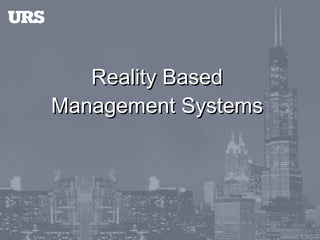Rbms 45 Min Tfm Show Final 4.10.06
- 1. Reality Based Management Systems
- 2. Introduction
- 3. History Smith Kline Beecham Protectoseal Wm. Wrigley Jr. Company Safety Culture URS/BP Alliance World Class EHS
- 4. Benefits Reality Based Management Systems Reduced operating costs Lower accident and injuries Links key objectives on the project Project represents true tasks Document related to work tasks Establish clear lines of communication Establishes the correct hazard controls
- 5. Definition Reality Based Management Systems (RBMS) Involvement of all employees in the management process through linked elements and communication, with true reality of tasks communicated in the RBMS documents by allowing for time and planning.
- 6. Definition Reality Based Management Systems (RBMS) Applies the perspective of employees in real work situations to the overall management system. Integrates all employees in a bottom-up, employee-centered management process that targets the key elements and seven principles of RBMS.
- 7. Seven Principles Measure performance Participation at all levels that develops leadership Use real world tasks Foster respect and truth Perform hazard assessments on key target risks Organize project tasks and prevents retrofits Training performed on target hazards
- 8. 14 Elements Plan, Measure, and Improve Employee participation Leadership Roles and responsibilities Behaviors Hierarchy of controls/hazard analysis Reality based engineering (safety by design)
- 9. 14 Elements Plan, Measure, and Improve 7. Communication and training on key project hazards 8. Document control 9. Measure/performance metrics 10. Incident investigation/near-miss reporting 11. Audits/inspections 12. Evaluation of corrective action 13. Safety committee 14. Management review
- 11. Employee Participation At All Levels of the Project Working with hazards Invite employees to Plan Implement Evaluate
- 12. Leadership
- 13. Leadership Emotionally intelligent Goal-oriented Results-oriented Planner Hands-on Focused and responsible Team builder
- 14. Roles & Responsibility Supervisors/managers have face-to-face interaction with teams Clear goals and objectives Define roles and responsibility Project integration of Environmental Health and Safety (EHS) into the business systems Allow for financial support and time Define Standard Operating Procedures (SOP) linked to training
- 15. Behaviors
- 16. Behaviors Reward safe behavior and recognition Positive attitudes are developed by truth and reality of tasks Respect and care about others Observe behavior Identify conflicting behavior and take action
- 17. Hierarchy of Controls Safety Glasses Hearing Protection Respirators Gloves 5) Personal Protective Equipment LEAST EFFECTIVE Safe Job Procedures Work Instructions Inspections Training Hazard Assessments 4) Administrative Controls Signs Backup Alarms Beepers Horns 3) Warnings Ventilation Machine Guarding Ergonomics Remote Reader 2) Engineering Controls Substitute<Hazardous Reduce Speed Force Change Process MOST EFFECTIVE 1) Elimination or Substitution Examples Controls
- 18. Hierarchy of Controls Nature and extent of the risk controlled Degree of risk reduction desired Requirements of applicable federal and state standards Best practices recognized Available technologies Cost-effectiveness Internal organization standards
- 19. Hazard Analysis Safe Work Plan Hazard Analysis
- 20. Hazard Analysis Three Levels of Project Hazard Analysis Level 1 - Project-Specific Plans Design Phase of Project Safety Management Standards by Risk Profile Specific Tasks on Project Level 2 - Work Activity/Phase Risk Control Profile Safety by Design Controls Equipment Level 3 - Daily Task Analysis/Tool Box Discuss Specific Risks and Controls Establish Task and Equipment Material List
- 22. Reality Based Engineering Safety by design New process/operation/equipment Changes to existing operation Management of Change (MOC) Identify tasks Hazard associated with human factors Control measures Regulations/codes Scope and degree of design review
- 23. Communication
- 24. Communication Reality based training and awareness Training awareness linked to hazard assessment targets Training matrix includes compliance, policies, and hazards Employees exposed to hazard edit forms and documents
- 25. Communication Triangle of communication - face-to-face, phone, and e-mail Keep communications simple, open, and direct Use verbal communication and checklists Ask questions and verify communication
- 26. Document Control
- 27. Document Control ISO style of document control Updates annually Document format consistent Dates of revision Readable, identifiable and accessible All documents electronic with back-up Document review - PM, EHS manager, employees, and safety committee Obsolete documents removed from all points of issue and points of use
- 28. Measure
- 29. Measure Measure real performance not numbers Attainability Specify key target risks Base on leading indicators System improvements Achieving objectives Not only injuries and illness Measure to improve or manage process
- 31. Performance Metrics Identify critical activities Analyze key controls Drive appropriate behavior Establish goals and targets Assign responsibility Take corrective action Review measurements
- 33. Incident Investigation Follow the safety management standard Incident calling tree Emergency calling cards Train employees on incident reporting All incidents reviewed by EHS professional
- 35. Audits/Inspections Audits cover facility hazard profile Inspections developed by employees and safety committee Metrics linked to audits and inspections Linked to communication and training Performed by employees
- 37. Corrective Actions Issues are reported and corrected Work orders issued to repair equipment Safety committee establishes action items monthly Near-miss reporting with follow-up
- 38. Safety Committee
- 39. Safety Committee Establish team participation Initial/ongoing review Safety moments Develop action list Review 14 elements of RBMS Near-misses Lessons learned Issues that need immediate action
- 41. Management Review Relate to business management system Hazard and control Resources Regulations and standards Other relevant activities
- 42. Accomplishments Systems Management Process Reduced operating costs Better employee performance Simple standard operating procedures Reduced accidents Increased employee participation Management is respected Open lines of communication MOC includes safety by design
- 43. Conclusion Reality Based Management Systems Links key objectives on the project Project represents true tasks Documents designed and edited by teams Clear communication Identifies/establishes correct hazards controls All about people
- 44. Contact Info Rich Petitte URS Corporation 100 S. Wacker Drive Suite 500 Chicago, IL 60606 312.697.7254 [email_address]











































![Contact Info Rich Petitte URS Corporation 100 S. Wacker Drive Suite 500 Chicago, IL 60606 312.697.7254 [email_address]](https://image.slidesharecdn.com/rbms45mintfmshowfinal41006-12540056207392-phpapp03/85/Rbms-45-Min-Tfm-Show-Final-4-10-06-44-320.jpg)